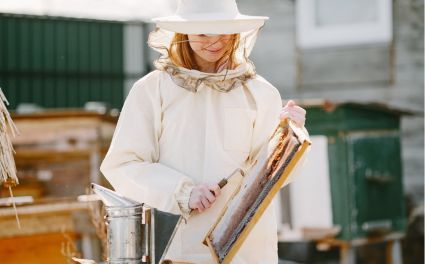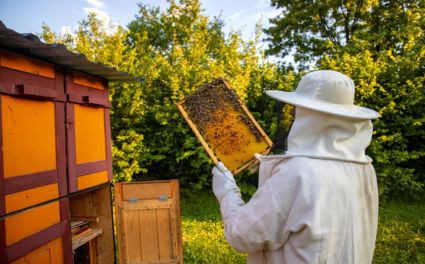Successful beekeeping goes far beyond setting up a hive and letting bees do their thing. To truly thrive, a colony needs thoughtful care, planning, and consistent attention. This is where hive management comes in — a skill that separates beginner beekeepers from seasoned pros.
From controlling swarms to managing your queen bee and keeping the colony healthy, hive management ensures your bees are productive and resilient throughout the year. Let’s explore some essential strategies every beekeeper can use.
The Basics of Hive Management
Every strong colony starts with consistent and mindful beekeeping hive care. Regular inspections give you insights into the colony’s health, honey reserves, and brood pattern. During inspections, beekeepers should:
-
Check brood frames for healthy eggs and larvae.
-
Monitor honey stores and add supers when needed.
-
Look for signs of pests, diseases, or overcrowding.
These hive inspection tips help you stay ahead of issues before they become major problems. One of the best hive maintenance best practices is keeping detailed records of each inspection — noting queen performance, hive population size, and seasonal changes.
Of course, safe inspections start with the right protective gear. Lightweight beekeeping jackets or full beekeeping suits from OZ Armour give you confidence to work closely with your bees while staying sting-free.

Swarm Control in Beekeeping
Swarming is a natural behaviour, but for beekeepers, it can mean losing half the colony and reducing honey production. Understanding why swarms happen is key to hive population control.
Why Bees Swarm
-
Overcrowding in the hive.
-
A strong colony with an ageing queen.
-
Lack of space for brood expansion.
Swarm Control Strategies
-
Splitting hives: Divide strong colonies into smaller units to reduce congestion.
-
Adding supers: Create more storage and brood space.
-
Seasonal hive management: Inspect more frequently in spring when swarming is most likely.
During these manipulations, sting protection is crucial. Flexible beekeeping gloves and breathable beekeeping trousers allow you to handle frames and supers comfortably while staying protected.
Queen Bee Management
The queen is the heart of the hive. Without strong queen bee management, colonies can quickly weaken.
Signs of a Weak or Failing Queen
-
Patchy brood pattern.
-
Low egg-laying activity.
-
Increased aggression in worker bees.
Requeening and Brood Frame Management
If the queen shows signs of decline, it may be time for requeening. Introducing a new queen restores productivity and improves hive stability. Managing brood frames — ensuring eggs, larvae, and capped brood are balanced — is also essential for long-term colony health.
When requeening or handling brood frames, your face and neck are most at risk from stings. A high-visibility beekeeping veils keeps you safe while giving you clear vision to work with precision.
Hive Population and Colony Health
Balanced colonies are productive colonies. Too few bees and the hive can’t defend itself; too many and swarming may occur. Proactive hive management helps maintain this balance.
Tips for Colony Health
-
Rotate brood frames to avoid congestion.
-
Inspect regularly for pests such as Varroa mites or small hive beetle.
-
Ensure adequate food supply during nectar dearths.
Proper beehive organisation also plays a role. By giving bees structured space for brood, honey, and pollen, you encourage natural order while maximising productivity. For added safety, protective add-ons like beekeeping ankle protection prevent stings when bees crawl upwards from the ground.
Seasonal Hive Management Strategies
Every season brings new challenges and opportunities for beekeepers. Adapting your approach with seasonal hive management ensures year-round success.
Spring Hive Management
-
Inspect hives frequently to monitor expansion.
-
Split strong colonies to prevent swarming.
-
Add supers to prepare for nectar flow.
Summer Hive Management
-
Ensure ventilation to keep hives cool.
-
Harvest honey carefully to avoid stressing bees.
-
Monitor hive population control closely.
Autumn Hive Management
-
Consolidate honey stores.
-
Check queen health and requeen if necessary.
-
Reduce entrances to prepare for colder months.
Winter Hive Management
-
Insulate hives to conserve heat.
-
Provide supplementary feeding if stores are low.
-
Perform minimal but essential inspections to avoid disturbing clusters.
These seasonal adjustments, paired with reliable beekeeping suits for kids for young learners and full protective gear for adults, keep the entire beekeeping family safe year-round.
Advanced Hive Productivity Strategies
For those ready to take their beekeeping to the next level, consider these advanced methods:
-
Splitting hives to prevent swarms and create new colonies.
-
Practicing sustainable beekeeping practices such as natural comb building and selective breeding.
-
Using digital tracking tools to log hive inspection tips and monitor trends over time.
Advanced hive productivity strategies not only protect your current colonies but also lay the foundation for long-term growth and sustainability.

Conclusion
Managing your hive like a pro comes down to consistency, awareness, and adapting to your colony’s needs. With strong hive management — from swarm control to queen care, seasonal adjustments, and advanced productivity strategies — you’ll keep your bees healthier and more productive year after year.
Whether you’re a beginner or an experienced beekeeper, the key is staying proactive. Regular inspections, timely interventions, and careful attention to your queen and colony health will ensure your hive thrives.
With trusted protective clothing — from beekeeping jackets and gloves to veils, trousers, and full-body beekeeping suits — OZ Armour has everything you need for safe, confident hive management.
In beekeeping, good hive management isn’t just about keeping bees alive — it’s about helping them flourish. Want more insights? Read more blogs about beekeeping and explore expert tips from OZ Armour.












